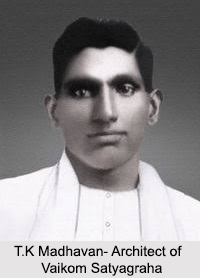 The Vaikom Satyagraha is the first organised movement against untouchability in India which took place in the year 1924 in the small town of Vaikom located in the current Kottayam district in Kerala. Vaikom was at that time a part of the princely state of Travancore. The Satyagraha aimed at securing freedom to all sections of society through the public roads leading to the Sri Mahadeva Temple at Vaikom. The role of Vaikom Satyagraha had a profound impact on the concept of movement and protest in India.
The Vaikom Satyagraha is the first organised movement against untouchability in India which took place in the year 1924 in the small town of Vaikom located in the current Kottayam district in Kerala. Vaikom was at that time a part of the princely state of Travancore. The Satyagraha aimed at securing freedom to all sections of society through the public roads leading to the Sri Mahadeva Temple at Vaikom. The role of Vaikom Satyagraha had a profound impact on the concept of movement and protest in India.
History of Vaikom Satyagraha
According to the prevalent caste system in Kerala and the rest of the country, low caste Hindus were not allowed to enter into the temples or even allowed to walk the same roads that led to the temples. In 1865, the Government of Travancore had published a notification that said all public roads in the state were open to all castes of people alike. This was re- modified in 1884 by a fresh notification which enjoined that any violation of these orders would be visited with the severest displeasure of the Government. A distinction was made between the Raja Veedhis or the King"s Highways and Grama Veedhis or the Village Roads. This eventually led to classism as the roads around Vaikom Temple were considered to be grama veedhis and consequently even after 65 years of Government proclamation, they were barred to the lower castes and a unit of police was stationed in the vicinity to enforce the custom.
Incidents Leading to Vaikom Satyagraha
Under the reign of Avittom Thirunal Balarama Varma, the king of Travancore, the first ever attempt to enter a temple was made by a group of 200 Ezhava or the Nadar community. The king single- handily along with a dozen of Nair warriors scared the Ezhavas away. Another incident which triggered the Vaikom agitation was the prohibition of T.K Madhavan, an advocate. He was to appear before the honourable judge in a case on behalf of his client. The court was inside the compound of the Maharaja"s palace and as the advocate belonged to the Nadar community he was denied entry.
This incident was made into an issue and thus sparked the movement of Vaikom Satyagraha. T.K Madhavan`s main objective was to achieve unconditional temple entry; he understood that the right to use the public roads around the temples was the first step. It was suggested in making the Vaikom Satyagraha a symbolic battle against atrocities in the name of caste, giving it a national and cosmopolitan look to gain the attention of the entire world. And to achieve that, the involvement of the Indian National Congress was necessary.
Effects of Vaikom Satyagraha
The movement gained prominence in the entire India and support came from far and wide. The Akalis of Punjab supported by setting up kitchens to provide food to the Satyagrahis and even the Christian and Muslim leaders were in support of the movement. This was shunned by Gandhiji because he wanted the movement to be an intra-Hindu affair. On Gandhi"s advice, the movement was taken back temporarily in April 1924. After discussions with Hindu caste people failed, the leaders again started the movement. Leaders T K Madhavan and K P Kesava Menon were arrested and later Periyar E. V. Ramasamy came from Tamil Nadu to show his support but was arrested.
On 1st October 1924, a group of savarnas or upper castes, marched in a procession and submitted a petition to the Regent Maharani Sethulakshmi Bai of Travancore with approximately 25000 signatures for allowing entry to the temple for everyone. Gandhijii also met with the Regent Maharani. This procession of savarnas was led by Mannath Padmanabhan Nair, beginning with about 500 people at Vaikom. The number increased to approximately 5000 when the procession reached Thiruvananthapuram in the month of November 1924.
And finally on 23rd November, 1925, all the gates of the temple were opened to Hindus except the eastern gate. In 1928, the backward castes got the right to walk on public roads leading to all temples in Travancore. This was the first time that an organised movement was being conducted on such a massive scale for the basic rights of the untouchables and other backward castes in Kerala.



















